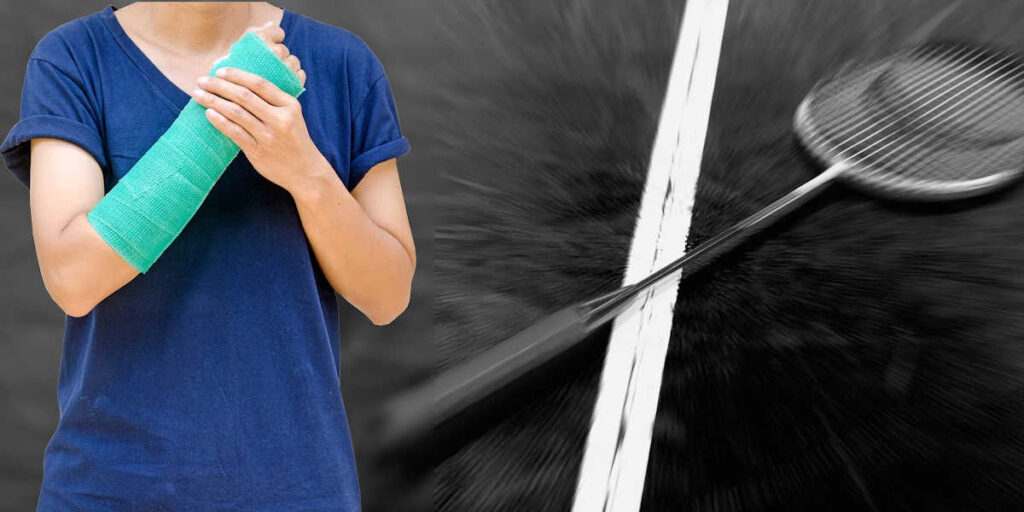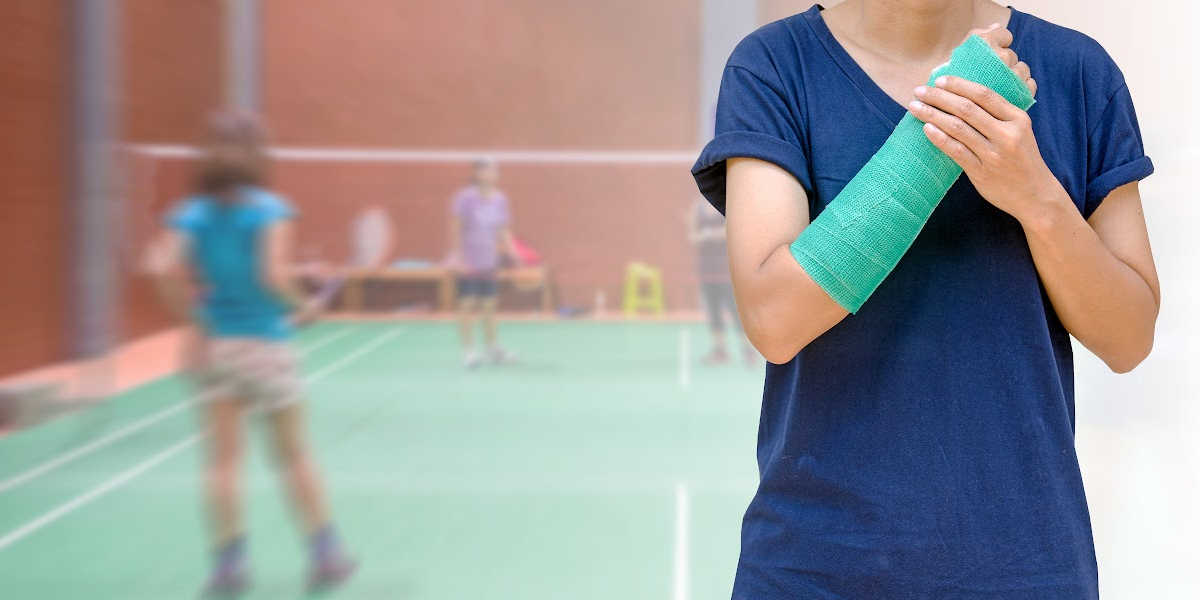Badminton involves muscles from your entire body. And it is not unusual to sustain injuries to any of these muscles while playing. Some of the common badminton injuries are:
- Ankle Sprain
- Wrist Sprain
- Tennis Elbow
- Golfer’s Elbow
- Shoulder Impingement
- Knee Injuries
- Back Injuries
- Blisters
- Hamstring Strain
- Calf Strain
- Groin Strain
These injuries can be prevented by employing proper care techniques. Each injury is caused by different reasons, and there are separate ways to avoid it. We will look at them all in this article.

Ankle Sprain
An ankle sprain occurs when ligaments in the ankle joint stretch or tear beyond their normal range of motion. It is a common injury in badminton due to the rapid changes in direction and jumping.
Causes
- Twisting or rolling the ankle, often when landing after a jump.
- Stepping on another player’s foot or an uneven surface.
- Sudden changes in direction while playing.
Symptoms
- Pain in the injured area.
- Swelling and bruising around the ankle joint.
- Difficulty walking or putting weight on the ankle.
- Tenderness to the touch.
- Limited range of motion in the ankle joint.

Wrist Sprain
A wrist sprain is a stretch or tear of the ligaments in the wrist joint. This injury is common in badminton due to the frequent use of the wrist in various shots.
Causes
- Falling on an outstretched hand during a lunge or dive.
- Forceful backhand strokes with improper technique.
- Weak wrist muscles that can’t handle the demands of the game.
Symptoms
- Pain and tenderness in the wrist.
- Swelling and bruising.
- Difficulty moving the wrist or gripping objects.
- A popping or tearing sensation at the time of injury.
Tennis Elbow
Tennis elbow is a condition where the tendons that join the forearm muscles to the outside of the elbow become inflamed or degenerated. This is often due to overuse of the elbow. It is common in racket sports like badminton.
Causes
- Repetitive motion of the wrist and arm.
- Improper technique, especially with backhand shots.
- Overuse without adequate rest.
Symptoms
- Pain and burning on the outside of the elbow.
- Weak grip strength.
- Pain that worsens with gripping or lifting objects.
- Tenderness and stiffness in the elbow.
Golfer’s Elbow
The Golfer’s Elbow is similar to the Tennis Elbow. The only difference is that, in this case, the tendons attached to the inner side of the elbow become inflamed. Meanwhile, in tennis elbow, the tendons of the outer side are involved.
Causes
- Repetitive gripping or lifting activities.
- Improper technique, especially with forehand shots.
- Overuse of the forearm muscles without adequate rest.
Symptoms
- Pain and tenderness on the inside of the elbow.
- Stiffness and weakness in the wrist.
- Numbness or tingling radiating into the fingers.
- Pain that worsens with gripping or flexing the wrist.
Shoulder Impingement
Shoulder impingement occurs when the tendons in the shoulder rub against the shoulder bone. This causes pain and inflammation in the shoulder.
Causes
- Repetitive overhead activities, such as serving or smashing in badminton.
- Poor posture or improper technique.
- Weakness or imbalance in the shoulder muscles.
Symptoms
- Pain and weakness in the shoulder.
- Difficulty lifting the arm above the head.
- Pain that worsens at night.
- A feeling of stiffness or catching when moving the shoulder.
Knee Injuries
Badminton players can sustain various types of knee injuries, including ligament sprains like ACL, MCL, PCL, meniscus tears, and patellar tendinitis, also known as jumper’s knee.
Causes
- Sudden twists, turns, or impacts.
- Overuse or improper technique.
- Direct blows to the knee or falling.
Symptoms
- Pain and swelling.
- Instability or a feeling of the knee giving out.
- Limited range of motion and difficulty straightening the knee.
- Popping or clicking sounds at the time of injury.
Back Injuries
Back injuries in badminton can involve muscle strains or sprains in the lower back. They can range from muscle strains to more serious issues like herniated discs.
Causes
- Sudden, awkward movements or improper lifting techniques.
- Poor posture during play.
- Overuse or repetitive stress on the back muscles.
Symptoms
- Pain and stiffness in the back.
- Muscle spasms.
- Limited range of motion.
- Pain radiates down the legs if nerves are affected.
Blisters
Blisters are fluid-filled pockets that develop on the skin due to friction. In badminton, they can occur on the feet from improper-fitting shoes or excessive moisture.
Causes
- Rubbing of the skin against shoes or equipment.
- Prolonged activity without proper footwear.
- Moisture and heat increase friction.
Symptoms
- Painful, fluid-filled bumps on the skin.
- Redness and swelling around the blister.
- Tenderness and discomfort.
Hamstring Strain
A hamstring strain involves overstretching or tearing of the hamstring muscles located in the back of the thigh. This injury is common in sports involving sprinting or sudden acceleration and deceleration.
Causes
- Sudden starts or stops.
- Overstretching the muscle.
- Poor flexibility or muscle imbalance.
Symptoms
- Sharp pain in the back of the thigh.
- Swelling and bruising.
- Muscle weakness and difficulty walking.
- A popping or snapping sensation at the time of injury.
Calf Strain
A calf strain is an overstretching or tearing of the calf muscle located in the lower leg. This injury is usually similar to a hamstring strain. It is just located in a different body part.
Causes
- Sudden pushing off or jumping movements.
- Overstretching the muscle.
- Poor conditioning or muscle fatigue.
Symptoms
- Sharp pain in the calf.
- Swelling and bruising.
- Muscle tightness and weakness.
- Difficulty walking or standing on tiptoe.
Groin Strain
A groin strain happens because of overstretching or tearing of the muscles in the groin area. Now, this might sound uncommon but it is possible while playing badminton.
Causes
- Sudden changes in direction.
- Overstretching the muscles.
- Poor conditioning or muscle imbalance.
Symptoms
- Pain in the inner thigh or groin area.
- Swelling and bruising.
- Muscle tightness and weakness.
- Difficulty bringing the legs together or lifting the knee.
Common Treatments for These Badminton Injuries
Here are some of the common treatments that could work for most of these injuries.
- Rest: Take rest and avoid activities that cause pain.
- Ice: Apply ice packs to reduce swelling and pain.
- Compression: Use an elastic bandage to support the affected muscle.
- Elevation: Keep the leg elevated to decrease swelling in the legs.
- Pain relievers: Use over-the-counter pain relief medications like ibuprofen or acetaminophen.
- Physical therapy: Do stretching and strengthening exercises to restore function.
- Gradual return to activity: Slowly resume activities as the muscle heals.
- Chiropractic care: Go to a chiropractor for alignment of affected muscles and bones.
Remember, these are just common treatments. You must get your injuries checked by a doctor. They can assess your needs and provide tailored treatment options.
Prevention of Badminton Injuries
To prevent badminton injuries, you can do the following:
- Warm-up: Proper warm-up and stretching before playing.
- Strengthening: Do regular exercises to strengthen the muscles.
- Flexibility: Maintain good flexibility with regular stretching.
- Avoid sudden, intense movements: Gradually increase intensity during play.
- Proper Technique: Focus on proper footwork and leg positioning during lunges and other movements.
- Proper Clothing: Wear badminton-specific shoes that fit well and provide adequate cushioning. Also, wear moisture-absorbing socks to absorb sweat and reduce friction.
- Maintain Good Posture: Focus on proper posture throughout gameplay. Keep your back straight and core engaged.
- Use Elbow Braces: Consider wearing elbow braces during gameplay, especially if you have a history of tennis elbow or experience pain during backhand strokes.
- Proper Grip Technique: Maintain a relaxed grip on the badminton racket during backhand strokes. Avoid gripping the racket too tightly.
Conclusion
While badminton injuries are common, there are ways to prevent them. Warm-up and cool-down routines play a major role in this. Without these, the chances of injuries increase significantly.
You can use the prevention techniques described in this article every day. Include them in your daily routines so they become a common part of your routine. Do let me know in the comments if any of you have a special routine just for using these techniques. It might help your fellow badminton players.
FAQs
What are the most common badminton injuries?
The most common badminton injuries are ankle sprain, knee injury, shoulder strain, back pain, and wrist sprain.
Can badminton injuries be prevented?
Yes, badminton injuries can be prevented by doing a proper warm-up and cool-down routine before and after the game.
Can I continue playing badminton if I have a previous injury?
If you are not in pain from the previous injury or there is no danger of further injury, then you can continue playing badminton.
How important is warming up before playing badminton?
Warming up before playing badminton is extremely important because it gives your muscles a chance to ease into the strenuous play that lies ahead.
When i stop playing badminton?
The decision to stop playing badminton is based on personal factors, such as physical health, any experiencing persistent injuries, a loss of interest in this sport or changes in any major life circumstance.
Is badminton puncture skull?
It is unlikely that a badminton racket will puncture the skull, as it is light and not made to withstand such force. Extreme impact can cause severe trauma, but penetrating a skull is unlikely.
How long should I wait before returning to badminton after an injury?
The waiting period varies depending on the severity of the injury. You shouldn’t feel any sharp pain or discomfort before stepping onto the court again.
Can I do any badminton-related training during my recovery?
Yes, you can engage in low-impact, badminton-related exercises as part of your recovery, but only as advised by your healthcare provider or physiotherapist. Think of some technique-related work in a sitting position if your foot is injured or vice versa
How can I tell if I’m pushing myself too hard during recovery?
Signs of overexertion include increased pain, swelling in the injured area, and prolonged fatigue. Listen to your body and give it the rest it needs.
